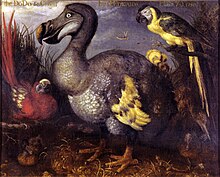
Macaws are a group of New World parrots that are long-tailed and often colorful. They are popular in aviculture or as companion parrots, although there are conservation concerns about several species in the wild.

The family Psittacidae or holotropical parrots is one of three families of true parrots. It comprises the 12 species of subfamily Psittacinae and 167 of subfamily Arinae including several species that have gone extinct in recent centuries. Some of the most iconic birds in the world are represented here, such as the blue-and-yellow macaw among the New World parrots and the grey parrot among the Old World parrots.

Anodorhynchus is a genus of large blue macaws from open and semi-open habitats in central and eastern South America. It includes two extant species, the hyacinth macaw and Lear's macaw also known as the indigo macaw, and one probably extinct species, the glaucous macaw. At about 100 centimetres (39 in) in length the hyacinth macaw is the longest parrot in the world. Glaucous and Lear's macaws are exclusively cliff nesters; hyacinth macaws are mostly tree nesters. The three species mainly feed on the nuts from a few species of palms.
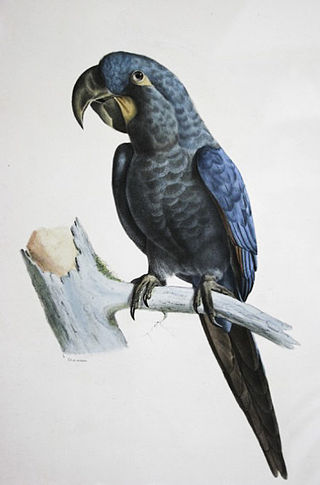
The glaucous macaw is a critically endangered or possibly extinct species of large, blue and grey South American parrot, a member of a large group of neotropical parrots known as macaws. This macaw is closely related to Lear's macaw and the hyacinth macaw. In Guaraní, it is called guaa-obi after its vocalizations.

The blue-and-yellow macaw, also known as the blue-and-gold macaw, is a large Neotropical parrot with a mostly blue dorsum, light yellow/orange venter, and gradient hues of green on top of its head. It is a member of the large group of neotropical parrots known as macaws. It inhabits forest, woodland and savannah of tropical Central and South America, as well as the island of Trinidad in the Caribbean. They are popular in aviculture because of their striking color, ability to talk, ready availability in the marketplace, and close bonding to humans.

The broad-billed parrot or raven parrot is a large extinct parrot in the family Psittaculidae. It was endemic to the Mascarene island of Mauritius. The species was first referred to as the "Indian raven" in Dutch ships' journals from 1598 onwards. Only a few brief contemporary descriptions and three depictions are known. It was first scientifically described from a subfossil mandible in 1866, but this was not linked to the old accounts until the rediscovery of a detailed 1601 sketch that matched both the subfossils and the accounts. It is unclear what other species it was most closely related to, but it has been classified as a member of the tribe Psittaculini, along with other Mascarene parrots. It had similarities with the Rodrigues parrot, and may have been closely related.
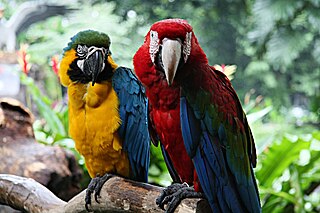
Ara is a Neotropical genus of macaws with eight extant species and at least two extinct species. The genus name was coined by French naturalist Bernard Germain de Lacépède in 1799. It gives its name to and is part of the Arini, or tribe of Neotropical parrots. The genus name Ara is derived from the Tupi word ará, an onomatopoeia of the sound a macaw makes.

The St. Croix macaw or Puerto Rican macaw, is an extinct species of macaw whose remains have been found on the Caribbean islands of St. Croix and Puerto Rico. It was described in 1937 based on a tibiotarsus leg bone unearthed from a kitchen midden at a pre-Columbian site on St. Croix. A second specimen consisting of various bones from a similar site on Puerto Rico was described in 2008, while a coracoid from Montserrat may belong to this or another extinct species of macaw. The St. Croix macaw is one of 13 extinct macaw species that have been proposed to have lived on the Caribbean islands. Macaws were frequently transported long distances by humans in prehistoric and historical times, so it is impossible to know whether species known only from bones or accounts were native or imported.

The neotropical parrots or New World parrots comprise about 150 species in 32 genera found throughout South and Central America, Mexico, the Caribbean islands and the southern United States. Among them are some of the most familiar and iconic parrots, including the blue and gold macaw, sun conure, and yellow-headed amazon.

The Cuban macaw or Cuban red macaw is an extinct species of macaw native to the main island of Cuba and the nearby Isla de la Juventud. It became extinct in the late 19th century. Its relationship with other macaws in its genus was long uncertain, but it was thought to have been closely related to the scarlet macaw, which has some similarities in appearance. It may also have been closely related, or identical, to the hypothetical Jamaican red macaw. A 2018 DNA study found that it was the sister species of two red and two green species of extant macaws.

The Lesser Antillean macaw or Guadeloupe macaw is a hypothetical extinct species of macaw that is thought to have been endemic to the Lesser Antillean island region of Guadeloupe. In spite of the absence of conserved specimens, many details about the Lesser Antillean macaw are known from several contemporary accounts, and the bird is the subject of some illustrations. Austin Hobart Clark described the species on the basis of these accounts in 1905. Due to the lack of physical remains, and the possibility that sightings were of macaws from the South American mainland, doubts have been raised about the existence of this species. A phalanx bone from the island of Marie-Galante confirmed the existence of a similar-sized macaw inhabiting the region prior to the arrival of humans and was correlated with the Lesser Antillean macaw in 2015. Later that year, historical sources distinguishing between the red macaws of Guadeloupe and the scarlet macaw of the mainland were identified, further supporting its validity.

The Dominican green-and-yellow macaw, Atwood's macaw or Dominican macaw, is an extinct species of macaw that may have lived on the island of Dominica. It is known only through the writings of British colonial judge Thomas Atwood in his 1791 book, The History of the Island of Dominica:
The macaw is of the parrot kind, but larger than the common parrot, and makes a more disagreeable, harsh noise. They are in great plenty, as are also parrots in this island; have both of them a delightful green and yellow plumage, with a scarlet-colored fleshy substance from the ears to the root of the bill, of which color is likewise the chief feathers of their wings and tails. They breed on the tops of the highest trees, where they feed on the berries in great numbers together; and are easily discovered by their loud chattering noise, which at a distance resembles human voices. The macaws cannot be taught to articulate words; but the parrots of this country may, by taking pains with them when caught young. The flesh of both is eat, but being very very fat, it wastes in roasting, and eats dry and insipid; for which reason, they are chiefly used to make soup of, which is accounted very nutritive.
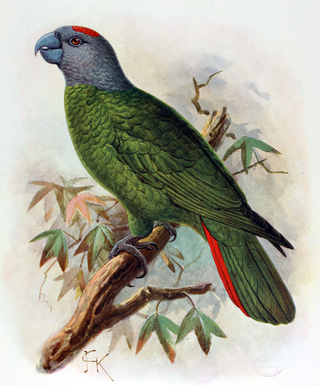
The Martinique amazon is a hypothetical extinct species of Caribbean parrot in the family Psittacidae. It is not known from any material remains, but was said to be similar to the red-necked amazon from Dominica, the next major island to the north of Martinique. Natives are known to have traded extensively in parrots between the Antilles, and it seems that the Martinique population was in some way related to or even descended from A. arausiaca.

The Guadeloupe amazon or Guadeloupe parrot is a hypothetical extinct species of parrot that is thought to have been endemic to the Lesser Antillean island region of Guadeloupe. Mentioned and described by 17th- and 18th-century writers, it received a scientific name in 1789. It was moved to the genus Amazona in 1905, and is thought to have been related to, or possibly the same as, the extant imperial amazon. A tibiotarsus and an ulna bone from the island of Marie-Galante may belong to the Guadeloupe amazon. In 1905, a species of extinct violet macaw was also claimed to have lived on Guadeloupe, but in 2015, it was suggested to have been based on a description of the Guadeloupe amazon.

The red-headed macaw or Jamaican green-and-yellow macaw may have been a species of parrot in the family Psittacidae that lived in Jamaica, but its existence is hypothetical.
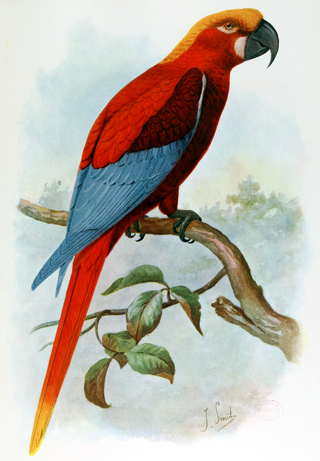
The Jamaican red macaw is a hypothetical species of parrot in the family Psittacidae that lived on Jamaica.

Several species have been assumed to exist, but due to a lack of physical evidence they can only be regarded as potential species. Hypothetical species are usually believed to be extinct. They have caused confusion, as they may have been a separate species, a subspecies, an introduced species or a misidentification.
Blue parrot or Blue Parrot may refer to:



